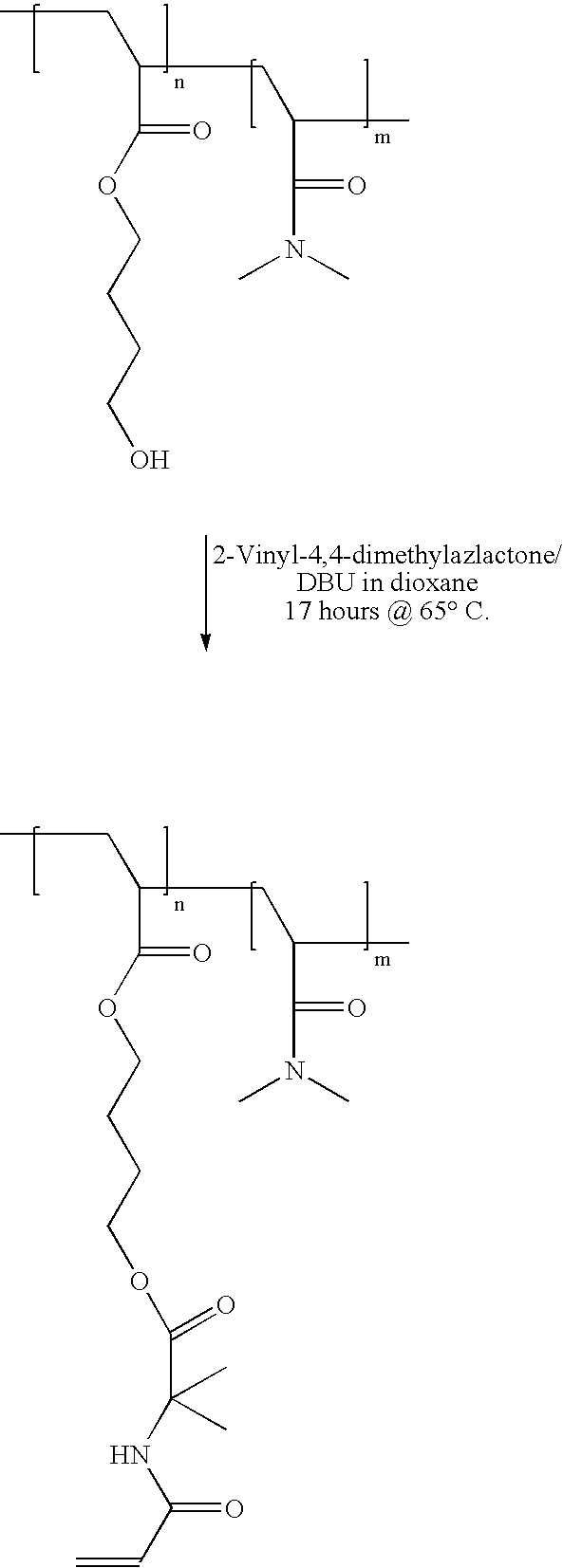Hydrophilic biomedical compositions
a biomedical composition and hydrophilic technology, applied in the field of hydrophilic ethylenically unsaturated macromonomers, can solve problems such as the need to take pla
- Summary
- Abstract
- Description
- Claims
- Application Information
AI Technical Summary
Benefits of technology
Problems solved by technology
Method used
Image
Examples
example 1
[0046]This Example illustrates the preparation and testing of a composition according to the present invention.
[0047]A hydrophilic poly(HBA-co-DMA) copolymer was synthesised by dissolving 2.0013 g 4-hydroxybutyl acrylate monomer (Aldrich Cat. No. 27,557–3) and 6.0755 g N,N-dimethylacrylamide monomer (Aldrich Cat. No. 27,413–5) in 120 ml 1,4-dioxane in a 250 ml round bottom flask equipped with a stirrer bar. 0.123 g (1 mole percent) of azobisisobutyronitrile (AIBN) initiator was added, and the monomer solution was freeze-thaw degassed four times. After reaction at 70° C. for 16 hours, the copolymer was isolated by precipitation into hexane, and was dried in vacuo at 40° C. for 4 hours to yield 6.25 g of a white, powdery polymer.
[0048]1.88 g of the polymer was dissolved in 20 ml 1,4 dioxane in a 50 ml round bottom flask equipped with a stirrer bar and nitrogen purge. 70 milligrams of 1,8-diazabicyclo[5.4.0]-undec-7-ene (DBU) (Aldrich Cat. No. 13,900–9) was added, followed by 0.4801 g ...
examples 2 and 3
[0050]These Examples illustrate the preparation and testing of two further compositions according to the present invention.
[0051]Example 1 was repeated except that the solids content was reduced to 25% (Example 2) and 20% (Example 3) to produce the results set out in Table 2.
[0052]
TABLE 2Mole %FormulationShearacrylamidesolids contentmodulusExamplefunctionalised(wt %)(kPa)252516.035202.1
PUM
| Property | Measurement | Unit |
|---|---|---|
| length | aaaaa | aaaaa |
| refractive index | aaaaa | aaaaa |
| water content | aaaaa | aaaaa |
Abstract
Description
Claims
Application Information
 Login to View More
Login to View More - R&D
- Intellectual Property
- Life Sciences
- Materials
- Tech Scout
- Unparalleled Data Quality
- Higher Quality Content
- 60% Fewer Hallucinations
Browse by: Latest US Patents, China's latest patents, Technical Efficacy Thesaurus, Application Domain, Technology Topic, Popular Technical Reports.
© 2025 PatSnap. All rights reserved.Legal|Privacy policy|Modern Slavery Act Transparency Statement|Sitemap|About US| Contact US: help@patsnap.com



